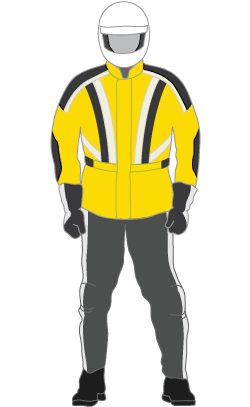Road safety
All the gear, all the time
Most crashes involve falling off your motorcycle but street clothes won't protect you from injuries. Good riding gear can save you from road rash, broken bones, or worse. So the real question is, why wouldn't you wear all the gear, all the time?
Collision coverage
If you have ICBC Collision coverage for your motorcycle, you can claim up to $1,500 for the protective gear that requires repair or replacement after a crash.
Choose the right gear
Wearing the proper gear can save your skin in a crash. Follow our guidelines on choosing gear that provides the most protection for you.

Full-face helmet
The helmet is the most important piece of gear to protect against head injuries and fractures. Choose one with a full-face visor to guard against flying debris, watery eyes, and of course, bugs.
Leather or heavy fabric jacket
Increase your visibility with reflective material and bright colours. When it comes to impact and abrasion protection, leather can't be beat. However heavy textile or synthetic jackets offer comparable safety with added comfort in warmer weather.
Leather gloves that cover your wrists
In a crash, your hands may be the first part of you to hit the pavement. Be sure to choose sturdy gloves that cover your wrists and are made for motorcycle riding - work and mechanic's gloves simply don't cut it.
Abrasion-resistant pants with knee pads
Legs take most of the impact in a crash. Leather offers superior protection against exhaust burn, road rash, crushing, and dislocation, but textile riding pants are more versatile in varying weather conditions.
Heavy over-the-ankle boots with low heels
Good boots (avoid steel-toed) secure your feet on the foot pegs and road surfaces. Proper boots can prevent torn ligaments, sprains or even broken bones.
Wear an approved motorcycle helmet
All motorcycle riders and passengers must wear helmets that meet safety industry standards — it's the law in B.C. Protecting your head is one of the most important factors in preventing or reducing serious injuries.
Choose a helmet that meets or exceeds one of these safety standards:

Motorcycle Snell M2015

Motorcycle Snell M2010

Motorcycle Snell M2005

DOT label

ECE label
Ensure that your brand new helmet features:
the proper label and meets safety-helmet labelling requirements (check the manufacturer's manual for an expiry date);
a bright, visible colour (and add reflective tape to the sides and back); and
a full-face helmet for the best protection in a crash.
When to replace your helmet
Any helmet that's been in a crash should be replaced immediately. It's also recommended that you consider replacing your helmet if it's been dropped or shows any sign of wear.
